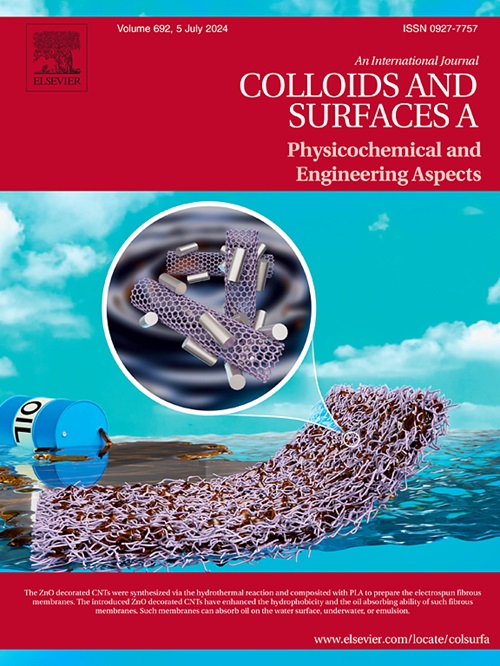Corrosion behavior and underlying mechanisms of Sn-58Bi solder balls surfaces induced by EDTA, HEDP, DTPMPA, and DTPA via chelation reactions
IF 4.9
2区 化学
Q2 CHEMISTRY, PHYSICAL
Colloids and Surfaces A: Physicochemical and Engineering Aspects
Pub Date : 2025-06-24
DOI:10.1016/j.colsurfa.2025.137585
引用次数: 0
Abstract
Sn58Bi solder balls are crucial interconnect materials for low-temperature electronic packaging; however, their susceptibility to oxidation and corrosion compromises their reliability. This research hypothesizes that complexing agents can form stable complexes with metal ions through hydroxyl, carboxyl, phosphonic acid, and nitrogen atoms, which would enhance the surface activity of Sn58Bi. This research systematically evaluated the chelating effects and mechanisms of four complexing agents—Ethylenediaminetetraacetic acid (EDTA), Diethylenetriamine pentaacetic acid (DTPA), Diethylenetriamine penta(methylene-phosphonic acid) (DTPMPA), and Etidronic acid (HEDP)—on Sn58Bi surfaces. Through comprehensive electrochemical testing, static weight loss experiments, and surface analyses (Scanning Electron Microscopy (SEM), Laser Scanning Confocal Microscopy (LSCM), X-ray Photoelectron Spectroscopy (XPS)) results indicate that these complexing agents significantly increase the corrosion current, reduce the corrosion potential, and accelerate corrosion-induced weight loss in HCl solution. These findings confirm their effective chelation and removal of surface metal ions. Surface morphology analysis further reveals variations in corrosion pit characteristics attributable to different complexing agents. All test results consistently rank the chelating ability of the agents as follows: DTPA > DTPMPA > EDTA > HEDP. Mechanistic analysis shows that DTPA, due to its molecular structure, forms multi-dentate ring-shaped complexes with metal ions through eight coordination bonds, exhibiting the highest chelating efficiency and structural stability, which is key to its superior chelating effects.
EDTA、HEDP、DTPMPA和DTPA通过螯合反应诱导Sn-58Bi焊料球表面腐蚀行为及其机理
Sn58Bi焊料球是低温电子封装的关键互连材料;然而,它们对氧化和腐蚀的敏感性降低了它们的可靠性。本研究假设络合剂可以通过羟基、羧基、膦酸、氮原子与金属离子形成稳定的配合物,从而提高Sn58Bi的表面活性。本研究系统评价了四种络合剂乙二胺四乙酸(EDTA)、二乙烯三胺五乙酸(DTPA)、二乙烯三胺五亚膦酸(DTPMPA)和乙替膦酸(HEDP)对Sn58Bi表面的螯合作用及其机理。综合电化学测试、静态失重实验和表面分析(扫描电镜(SEM)、激光扫描共聚焦显微镜(LSCM)、x射线光电子能谱(XPS))结果表明,这些络合剂显著增加了HCl溶液中的腐蚀电流,降低了腐蚀电位,加速了腐蚀失重。这些发现证实了它们对表面金属离子的有效螯合和去除。表面形貌分析进一步揭示了不同络合剂对腐蚀坑特性的影响。所有测试结果一致地对药剂的螯合能力进行了如下排序:DTPA >;DTPMPA祝辞EDTA祝辞 HEDP。机理分析表明,DTPA由于其分子结构,通过8个配位键与金属离子形成多齿状环状配合物,具有最高的螯合效率和结构稳定性,这是其螯合效果优越的关键。
本文章由计算机程序翻译,如有差异,请以英文原文为准。
求助全文
约1分钟内获得全文
求助全文
来源期刊
CiteScore
8.70
自引率
9.60%
发文量
2421
审稿时长
56 days
期刊介绍:
Colloids and Surfaces A: Physicochemical and Engineering Aspects is an international journal devoted to the science underlying applications of colloids and interfacial phenomena.
The journal aims at publishing high quality research papers featuring new materials or new insights into the role of colloid and interface science in (for example) food, energy, minerals processing, pharmaceuticals or the environment.

 求助内容:
求助内容: 应助结果提醒方式:
应助结果提醒方式:


